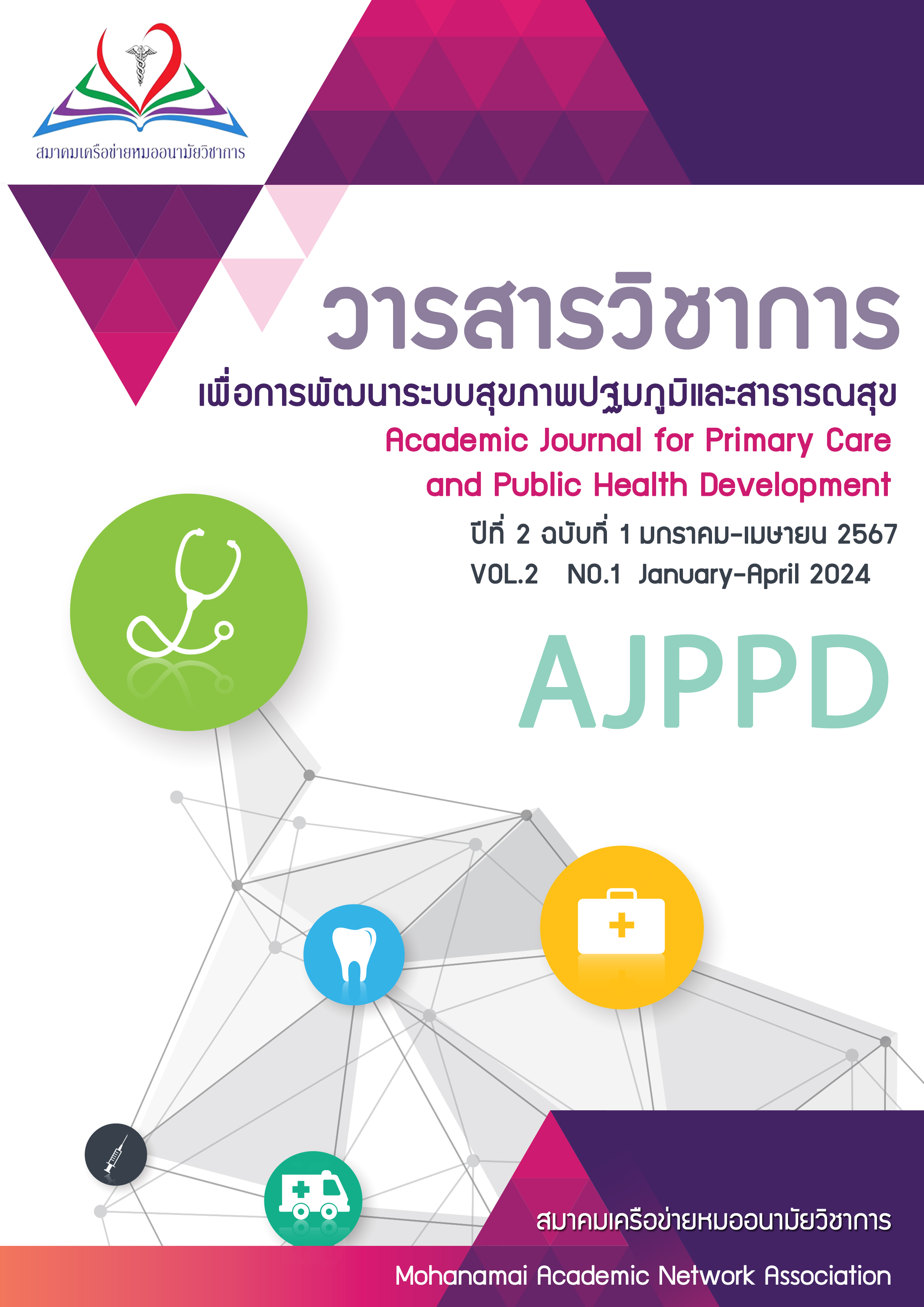ความสัมพันธ์ระหว่างคุณภาพชีวิตกับความสามารถในการปฏิบัติกิจวัตรประจำวัน ของผู้สูงอายุ ตำบลนากะชะ อำเภอฉวาง จังหวัดนครศรีธรรมราช
คำสำคัญ:
คุณภาพชีวิตผู้สูงอายุ, ความสามารถในการปฏิบัติกิจวัตรประจำวัน, ผู้สูงอายุบทคัดย่อ
การศึกษาวิจัยเชิงสำรวจแบบภาคตัดขวางมีวัตถุประสงค์เพื่อศึกษาคุณภาพชีวิต ความสามารถในการปฏิบัติกิจวัตรประจำวัน และศึกษาความสัมพันธ์ระหว่างคุณภาพชีวิตกับความสามารถในการปฏิบัติกิจวัตรประจำวันของผู้สูงอายุ ตำบลนากะชะ อำเภอฉวาง จังหวัดนครศรีธรรมราช ประชากรที่ใช้ศึกษาคือ ผู้สูงอายุ จำนวน 959 คน คำนวณกลุ่มตัวอย่างได้ 166 คน สุ่มกลุ่มตัวอย่างอย่างง่าย เครื่องมือที่ใช้เป็นแบบสอบถาม มีค่าค่าสัมประสิทธิ์แอลฟ่าของครอนบาช เท่ากับ 0.81 วิเคราะห์โดยใช้สถิติเชิงพรรณนา และ Spearman's rank correlation coefficient
ผลการวิจัย พบว่า คุณภาพชีวิตของทุกด้านอยู่ในระดับดี โดยคุณภาพชีวิตด้านสุขภาพโดยรวมมีค่าเฉลี่ยมากที่สุด (M= 4.07, SD.= 0.76) รองลงมาคือ คุณภาพชีวิตด้านสิ่งแวดล้อม (M= 3.92, SD.= 0.46) คุณภาพชีวิตด้านจิตใจ (M= 3.88, SD.= 0.49) คุณภาพชีวิตด้านสุขภาพกาย (M= 3.83, SD.= 0.44) และคุณภาพชีวิตด้านสัมพันธภาพทางสังคม (M= 3.81, SD.= 0.65) กลุ่มตัวอย่างส่วนใหญ่อยู่ในกลุ่มพึ่งตนเองได้ ช่วยเหลือผู้อื่นได้ (ติดสังคม) (ร้อยละ 81.33) เมื่อวิเคราะห์ความสัมพันธ์ระหว่างคุณภาพชีวิตกับความสามารถในการปฏิบัติกิจวัตรประจำวันของผู้สูงอายุ พบว่า คุณภาพชีวิตทุกด้านมีความสัมพันธ์ในทิศทางบวกอยู่ในระดับต่ำ โดยด้านที่มีความสัมพันธ์กันมากที่สุด คือ คุณภาพชีวิตด้านสิ่งแวดล้อม (r= 0.339) รองลงมาคือ คุณภาพชีวิตด้านสุขภาพกาย (r= 0.375) คุณภาพชีวิตด้านสัมพันธภาพทางสังคม (r= 0.275) คุณภาพชีวิตด้านจิตใจ (r= 0.258) และคุณภาพชีวิตโดยรวม (r= 0.251) ตามลำดับ
ฉะนั้น บุคลากรทางสุขภาพควรยังต้องให้ความสำคัญในการให้ความช่วยเหลือตนเองในกิจกรรมต่าง ๆ โดยเฉพาะการกลั้นปัสสาวะ ซึ่งผู้สูงอายุปฏิบัติได้น้อยที่สุด ทั้งนี้เพื่อเป็นการลดการพึ่งพาในระยะยาว และเป็นการส่งเสริมคุณภาพชีวิตอีกด้วย
References
กรมกิจการผู้สูงอายุ กระทรวงพัฒนาสังคมและความมั่นคงของมนุษย์. (2562). คู่มือการดำเนินงานอาสาสมัครพัฒนาสังคมและความมั่นคงของมนุษย์ (เชี่ยวชาญด้านผู้สูงอายุ). กรุงเทพมหานคร.
กรมกิจการผู้สูงอายุ กระทรวงพัฒนาสังคมและความมั่นคงของมนุษย์. (2564). สถิติผู้สูงอายุ. สืบค้นเมื่อวันที่ 25 กุมภาพันธ์ 2567. http://www.dop.go.th/th/know/1
กรมอนามัย. (2567). รายงานประจำปี 2566 สำนักอนามัยผู้สูงอายุ. กระทรวงสาธารณสุข.
เจษฎา นกน้อย และวรรณภรณ์ บริพันธ์. (2560). คุณภาพชีวิตของผู้สูงอายุในจังหวัดสงขลา. วารสารมหาวิทยาลัยนราธิวาสราชนครินทร์, 9(3), 94-105.
ชนาทิพย์ พลพิจิตร์, ชมนภัส มณีรัตน์, เกศแก้ว วิมนมาลา และเพ็ญศิริ สันตโยภาส. (2563). ความสามารถในการปฏิบัติกิจวัตรประจำวันของผู้สูงอายุในกรุงเทพมหานคร. วารสารเกื้อการุณย์, 27(2), 103-115.
ชูชัย ศุภวงศ์, สมศักดิ์ ชุณหรัศมิ์, ศุภกิจ ศิริลักษณ์, ลัดดา ดําริการเลิศ, สุพัตรา ศรีวณิชากร, เกษม เวชสุทธานนท์. (2553). คู่มือการให้บริการของโรงพยาบาลส่งเสริมสุขภาพตําบล. พิมพ์ครั้งที่ 2. นนทบุรี: กระทรวงสาธารณสุข.
นงนุช แย้มวงษ์. (2557). คุณภาพชีวิตและความสามารถในการทำกิจวัตรประจำวันของผู้สูงอายุที่มารับบริการในโรงพยาบาลศูนย์การแพทย์สมเด็จพระเทพ ฯ. วารสารการแพทย์และวิทยาศาสตร์สุขภาพ, 21(1), 37-44.
นริสา วงศ์พนารักษ์ และสายสมร เฉลยกิตติ. (2557). คุณภาพชีวิต: การศึกษาในผู้สูงอายุไทย. วารสารพยาบาลทหารบก, 15(3), 64-70.
โรงพยาบาลส่งเสริมสุขภาพตำบลบ้านนาเส. (2566). รายงานประจำปี 2566. นครศรีธรรมราช.
โรงพยาบาลส่งเสริมสุขภาพตำบลบ้านนาเส. (2567). รายงานประจำปี 2567 (6 เดือน). นครศรีธรรมราช.
สุภาภรณ์ ตันตินันทตระกูล, จิรกุล ครบสอน และนงลักษณ์ วิชัยรัมย์. (2565). ปัจจัยที่มีความสัมพันธ์กับคุณภาพชีวิตของผู้สูงอายุในชุมชนบางโพธิ์เหนือ อำเภอสามโคก จังหวัดปทุมธานี. วารสารสังคมศาสตร์และมานุษยวิทยาเชิงพุทธ, 7(11), 352-373.
สุวัฒน์ มหันนิรันดร์กุล, วิระวรรณ ตันติพิวัฒนสกุล, วนิดา พุ่มไพศาลชัย, กรองจิตต์ วงศ์สุวรรณ และราณี พรมานะจิรังกุล. (2540). เปรียบเทียบตัวชี้วัดคุณภาพชีวิตของ WHO 100 ตัวชี้วัด. เชียงใหม่: โรงพยาบาลสวนปรุง.
สำนักงานสาธารณสุขจังหวัดนครศรีธรรมราช. (2567). ข้อมูลผู้สูงอายุ. สืบค้นเมื่อวันที่ 20 มีนาคม 2567 จาก https://nrt.hdc.moph.go.th/hdc/reports/report.php?&cat_id=ac4eed1bddb23d6 130746d62d2538fd0&id=db4e8d42e1234a75bd03d430c31feb2f
สำนักงานสาธารณสุขอำเภอฉวาง. (2567). รายงานประจำปี 2567 (6 เดือน). สำนักงานสาธารณสุขจังหวัดนครศรีธรรมราช.
สำนักอนามัยผู้สูงอายุ. (2566). รายงานประจำปี 2566 สำนักอนามัยผู้สูงอายุ. นนทบุรี. กรมอนามัยกระทรวงสาธารณสุข.
Bartz, A. E. (1999). Basic statistical concepts. (4th Edition). New Jersey: Prentice–Hall.
Best, J. W. (1977). Research in Education. (3nded). Englewod Cliffs: Prentice-Hall.
Cohen, J. (1988). Statistical Power Analysis for the Behavioral Sciences. 2nd ed. Hillsdale, NJ: Lawrence Erlbaum Associates, Publishers.
Faul, F., Erdfelder, E., Lang, A. G., & Buchner, A. (2007). G*Power 3: A Flexible Statistical Power Analysis Program for the Social, Behavioral, and Biomedical Sciences. Behavior Research Methods, 39, 175-191.
World Health Organization. (1995). Measuring quality of life. Retrieved 20 September 2023, from https://www.apps.who.int/iris/bitstream/handle/10665/63482/WHO_MSA_MNH _PSF_97.4.pdf?sequence=1&isAllowed=y
World Health Organization. (1997). Division of Mental Health and Prevention of Substance Abuse. Life Skills Education in Schools. Geneva: World Health Organization.

Downloads
เผยแพร่แล้ว
How to Cite
ฉบับ
บท
License

This work is licensed under a Creative Commons Attribution-NonCommercial-NoDerivatives 4.0 International License.




